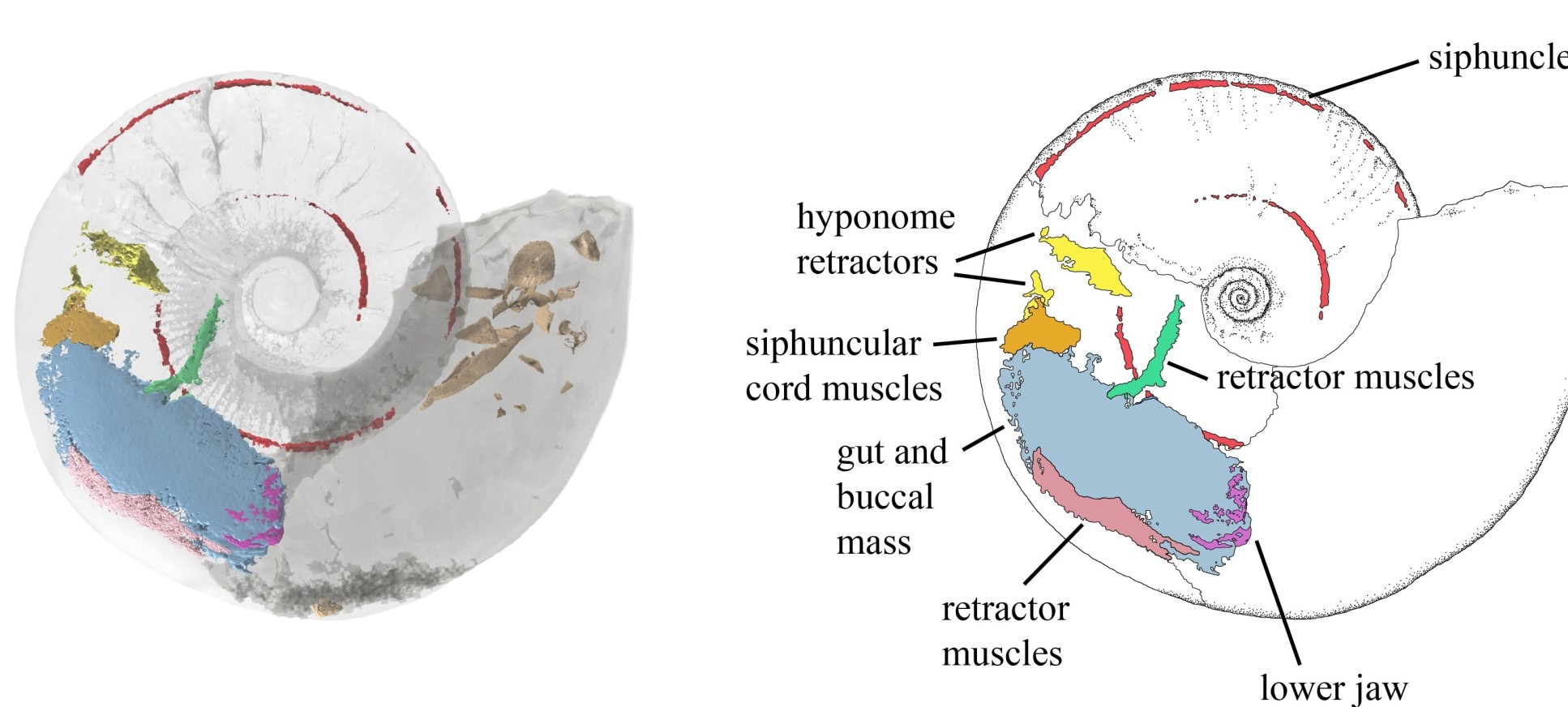Rare Jurassic fossil reveals never-before-seen ammonite muscles in 3D
For the first time, researchers have revealed the soft tissues of a 165-million-year-old ammonite fossil using 3D imaging.
They found that the now-extinct molluscs sported hyponomes: tube-like syphons through which water is expelled to jet propel animals forward in water, as found in modern squid and octopuses. They also found strong muscles that ammonites used to retract into their shells to defend against predators.

This is a major breakthrough in ammonite palaeobiology. Dr Alan Spencer Department of Earth Science and Engineering
The team, led by researchers from Cardiff University and including Imperial College London, found this by analysing the muscles and organs of an exceptionally well-preserved ammonite fossil found over 20 years ago in Gloucestershire, UK.
The research, published in Geology, marks the first time an ammonite’s softer parts have been visualised in three dimensions – and is thanks to a combination of modern technology, the fossil’s exceptional preservation, and collaboration across interdisciplinary teams and facilities.
The findings add insight into how ammonites lived and are evidence that coleoids, the sub-group of animals containing squid, octopuses, and cuttlefish, might be evolutionarily closer to ammonites than previously thought.
Study co-author Dr Alan Spencer, from Imperial’s Department of Earth Science and Engineering and the Natural History Museum, said: “This ammonite is remarkably well preserved, which is very rare. New imaging techniques allowed us to visualise the internal soft parts of ammonites that have so far resisted all our previous efforts to describe them. This is a major breakthrough in ammonite palaeobiology.”
Squid-like propulsion
Ammonites, which became extinct around 66 million years ago, once thrived in oceans as dinosaurs ruled the Earth. They are among the most common fossils worldwide, but almost everything we know about them so far is
Preservation of soft parts is exceptionally rare in ammonites, even in comparison to fossils of closely related animals like squid. Dr Lesley Cherns Cardiff University
based on their hard shells as these are more easily preserved over millennia than bodily tissues. Thus, ammonite fossils with preserved muscles and organs are extremely rare.
To carry out the study, the researchers studied the five-centimetres-across ammonite fossil which was found within an exposed Jurassic sediment at a Gloucestershire site in 1998. They looked at the fossil’s remaining soft tissues and scarring where muscles once attached to the inside of its shell.
By combining high-resolution X-ray and high-contrast neutron imaging, they created a detailed 3D computer reconstruction of the structure, size and orientation of its muscles and organs. From this detailed model, they were able to infer the functions of the muscles and organs.
The arrangement and relative strength of the muscles suggests ammonites swam by expelling water through their hyponomes, found next to the opening to the body chamber. This type of swimming, called jet propulsion, is used by a wide range of living animals, including cephalopods – the larger group to which ammonites belong.
The imaging also revealed paired muscles extending from the ammonite’s body, likely used to retract the animal deep into the body chamber for protection. This would have been an important anti-predator adaptation in ammonites, which lacked defensive features like the ink sac seen in modern relatives like octopuses, squid, and cuttlefish.
Patience yields results
This result is a testament to both the patience shown and the amazing ongoing technological advances in palaeontology. Dr Alan Spencer Department of Earth Science and Engineering
Because ammonites’ soft tissues are rarely preserved, scientists have used modern Nautilus as a ‘body-plan’ for reconstructing ammonite biology. However, this study highlights that ammonites and Nautilus may not be as similar as previously thought.
The study’s lead author Dr Lesley Cherns of Cardiff University said: “Preservation of soft parts is exceptionally rare in ammonites, even in comparison to fossils of closely related animals like squid. We found evidence for muscles that are not present in Nautilus, which provided important new insights into the anatomy and functional morphology of ammonites.”
The findings demonstrate that combining different imaging techniques can be highly effective for investigating fossil soft tissues, highlighting exciting possibilities for studying the internal structure of well-preserved specimens.

Dr Spencer added: “Despite being discovered over 20 years ago, scientists have resisted the destructive option of cutting it apart to see what’s inside. Although this would have been much quicker, it risked permanent loss of some information. Instead, we waited until non-destructive technology caught up – as it now has! This allowed us to understand these interior structures without causing this unique and rare fossil any damage.
“This result is a testament to both the patience shown and the amazing ongoing technological advances in palaeontology.”
“Correlative tomography of exceptionally preserved Jurassic ammonite implies hyponome-propelled swimming” by Lesley Cherns, Alan Spencer, Imran Rahman, Russell Garwood, Christopher Reedman, Genoveva Burca, Martin Turner, Neville Hollingworth and Jason Hilton, published 7 December 2021 in Geology.
-
The research team used a combination of cutting-edge facilities, including the ISIS Neutron and Muon Source at the STFC Rutherford Appleton Laboratory in Harwell and the Henry Moseley X-ray Imaging Facility (HMXIF) at the University of Manchester, to digitally reconstruct the inside of a ‘virtual ammonite’. Both the STFC and HMXIF generously provided valuable access to their facilities to support the research.
The work was carried out by researchers from Cardiff University, Imperial College London, the Natural History Museum, University of Manchester, ISIS Neutron and Muon Source, the Science and Technology Facilities Council (STFC) and the University of Birmingham. The fossil is housed at the National Museum Wales as part of their collection.
Images and videos: Cherns et al.
Article supporters
Article text (excluding photos or graphics) © Imperial College London.
Photos and graphics subject to third party copyright used with permission or © Imperial College London.
Reporter
Nicky Jenner
Department of Earth Science & Engineering
Caroline Brogan
Communications Division